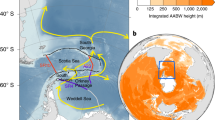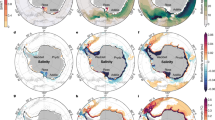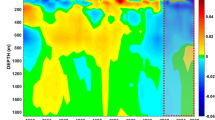Abstract
The transport of warm and salty Indian Ocean waters into the Atlantic Ocean—the Agulhas leakage—has a crucial role in the global oceanic circulation1 and thus the evolution of future climate. At present these waters provide the main source of heat and salt for the surface branch of the Atlantic meridional overturning circulation (MOC)2. There is evidence from past glacial-to-interglacial variations in foraminiferal assemblages3 and model studies4 that the amount of Agulhas leakage and its corresponding effect on the MOC has been subject to substantial change, potentially linked to latitudinal shifts in the Southern Hemisphere westerlies5. A progressive poleward migration of the westerlies has been observed during the past two to three decades and linked to anthropogenic forcing6, but because of the sparse observational records it has not been possible to determine whether there has been a concomitant response of Agulhas leakage. Here we present the results of a high-resolution ocean general circulation model7,8 to show that the transport of Indian Ocean waters into the South Atlantic via the Agulhas leakage has increased during the past decades in response to the change in wind forcing. The increased leakage has contributed to the observed salinification9 of South Atlantic thermocline waters. Both model and historic measurements off South America suggest that the additional Indian Ocean waters have begun to invade the North Atlantic, with potential implications for the future evolution of the MOC.
This is a preview of subscription content, access via your institution
Access options
Subscribe to this journal
Receive 51 print issues and online access
$199.00 per year
only $3.90 per issue
Buy this article
- Purchase on Springer Link
- Instant access to full article PDF
Prices may be subject to local taxes which are calculated during checkout





Similar content being viewed by others
References
Gordon, A. L. Interocean exchange of thermocline water. J. Geophys. Res. 91, 5037–5046 (1986)
Friocourt, Y., Drijfhout, S., Blanke, B. & Speich, S. Water mass export from Drake Passage to the Atlantic, Indian, and Pacific oceans: a Lagrangian model analysis. J. Phys. Oceanogr. 35, 1206–1222 (2005)
Peeters, F. J. C. et al. Vigorous exchange between Indian and Atlantic Ocean at the end of the last five glacial periods. Nature 400, 661–665 (2004)
Knorr, G. & Lohmann, G. Southern Ocean origin for the resumption of Atlantic thermohaline circulation during deglaciation. Nature 424, 532–536 (2003)
Bard, E. & Rickaby, R. E. M. Migration of the subtropical front as a modulator of glacial climate. Nature 460, 380–383 (2009)
Cai, W. Antarctic ozone depletion causes an intensification of the Southern Ocean super-gyre circulation. Geophys. Res. Lett. 33, L03712 (2006)
Biastoch, A., Böning, C. W. & Lutjeharms, J. R. E. Agulhas leakage dynamics affects decadal variability in atlantic overturning circulation. Nature 456, 489–492 (2008)
Biastoch, A., Lutjeharms, J. R. E., Böning, C. W. & Scheinert, M. Mesoscale perturbations control inter-ocean exchange south of Africa. Geophys. Res. Lett. 35, L20602 (2008)
Curry, R. & Mauritzen, C. Dilution of the northern North Atlantic Ocean in recent decades. Science 308, 1772–1774 (2005)
Lutjeharms, J. R. E. The Agulhas Current (Springer, 2006)
De Ruijter, W. P. M., Ridderinkhof, H., Lutjeharms, J. R. E., Schouten, M. W. & Veth, C. Observations of the flow in the Mozambique Channel. Geophys. Res. Lett. 29, 140–141 (2002)
Weijer, W., de Ruijter, W. P. M., Sterl, A. & Drijfhout, S. S. Response of the Atlantic overturning circulation to South Atlantic sources of buoyancy. Glob. Planet. Change 34, 293–311 (2002)
Speich, S., Blanke, B. & Cai, W. Atlantic meridional overturning circulation and the Southern Hemisphere supergyre. Geophys. Res. Lett. 34, L23614 (2007)
Sen Gupta, A. et al. Projected changes to the Southern Hemisphere ocean and sea-ice in the IPCC AR4 climate models. J. Clim. 22, 3047–3078 (2009)
Biastoch, A., Beal, L. M., Casal, T. G. D. & Lutjeharms, J. R. E. Variability and coherence of the Agulhas Undercurrent in a high-resolution ocean general circulation model. J. Phys. Oceanogr. 39, 2417–2435 (2009)
Large, W. G. & Yeager, S. G. Diurnal to Decadal Global Forcing for Ocean and Sea-Ice Models: the Data Sets and Flux Climatologies. (NCAR Technical Note NCAR/TN-460+STR, 2004)
Alory, G., Wijffels, S. & Meyers, G. Observed temperature trends in the Indian Ocean over 1960–1999 and associated mechanisms. Geophys. Res. Lett. 34, L02606 (2007)
Rouault, M., Penven, P. & Pohl, B. Warming in the Agulhas Current system since the 1980s. Geophys. Res. Lett. 36, L12602 (2009)
Böning, C. W., Dispert, A., Visbeck, M., Rintoul, S. & Schwarzkopf, F. V. The response of the Antarctic Circumpolar Current to recent climate change. Nature Geosci. 1, 864–869 (2008)
Swart, S. et al. Transport and variability of the Antarctic Circumpolar Current south of Africa. J. Geophys. Res. 113, C09014 (2008)
Blanke, B., Arhan, M., Madec, G. & Roche, S. Warm water paths in the equatorial Atlantic as diagnosed with a general circulation model. J. Phys. Oceanogr. 29, 2753–2768 (1999)
Van Sebille, E., Biastoch, A., van Leeuwen, P. J. & de Ruijter, W. P. M. A weaker Agulhas Current leads to more Agulhas leakage. Geophys. Res. Lett. 36, L03601 (2009)
Ridderinkhof, H. & De Ruijter, W. P. M. Moored current observations in the Mozambique Channel. Deep Sea Res. II 50, 1933–1955 (2003)
Matano, R. P., Beier, E. J. & Strub, P. T. Large-scale forcing of the Agulhas variability: the seasonal cycle. J. Phys. Oceanogr. 32, 1228–1241 (2002)
Ou, H. W. & de Ruijter, W. P. M. Separation of an inertial boundary current from a curved coastline. J. Phys. Oceanogr. 16, 280–289 (1986)
Biastoch, A., Reason, C. J. C., Lutjeharms, J. R. E. & Boebel, O. The importance of flow in the Mozambique Channel to seasonality in the greater Agulhas Current system. Geophys. Res. Lett. 26, 3321–3324 (1999)
Oke, P. & England, M. Oceanic response to changes in the latitude of the Southern Hemisphere subpolar westerly winds. J. Clim. 17, 1040–1054 (2004)
Meehl, G. et al. Global Climate Projections 747–846 (Cambridge Univ. Press, 2007)
Debreu, L., Vouland, C. & Blayo, E. AGRIF: Adaptive grid refinement in Fortran. Comput. Geosci. 34, 8–13 (2008)
Madec, G. NEMO Ocean Engine. Technical Report 27 (Note du Pôle de Modélisation, Institut Pierre Simon Laplace, 2006)
Barnier, B. et al. Impact of partial steps and momentum advection schemes in a global ocean circulation model at eddy permitting resolution. Ocean Dyn. 56, 543–567 (2006)
Zalesak, S. T. Fully multidimensional flux corrected transport algorithms for fluids. J. Comput. Phys. 31, 335–362 (1979)
Kalnay, E. et al. The NCEP/NCAR 40-years reanalysis project. Bull. Am. Meteorol. Soc. 77, 437–471 (1996)
Griffies, S. et al. Coordinated ocean-ice reference experiments (COREs). Ocean Model. 26, 1–46 (2009)
Béranger, K., Barnier, B., Gulev, S. & Crépon, M. Comparing 20 years of precipitation estimates from different sources over the world ocean. Ocean Dyn. 56, 104–138 (2006)
Latif, M. et al. Is the thermohaline circulation changing? J. Clim. 19, 4631–4637 (2006)
Biastoch, A., Böning, C. W., Getzlaff, J., Molines, J.-M. & Madec, G. Causes of interannual-decadal variability in the meridional overturning circulation of the mid-latitude North Atlantic Ocean. J. Clim. 21, 6599–6615 (2008)
Conkright, M. et al. World Ocean Database 2001 Vol. 1 Introduction 1–167 (NOAA Atlas NESDIS 42, US Government Printing Office 13, 2002)
Steele, M., Morfley, R. & Ermold, W. PHC: A global ocean hydrography with a high-quality Arctic Ocean. J. Clim. 14, 2079–2087 (2001)
Ridgway, K., Dunn, J. & Wilkin, J. Ocean interpolation by four-dimensional weighted least squares: application to the waters around Australasia. J. Atmos. Ocean. Technol. 19, 1357–1375 (2002)
Acknowledgements
The integrations of the experiments have been performed at the Höchstleistungsrechenzentrum Stuttgart (HLRS) and the Computing Centre at Kiel University. We thank the NEMO, AGRIF and Ariane System Teams for their technical support. The analysis was supported by the DFG projects BO 907/2-2 and SFB 754 (TP A2, http://www.sfb754.de). J.R.E.L. received support from the International Bureau of the BMBF (SUA 07/004) and from the South African National Research Foundation.
Author Contributions A.B. and C.W.B. conceived the experimental concept. A.B. implemented and conducted the experiments, and carried out the analysis. F.U.S. performed the observational analysis. All authors discussed the results and jointly wrote the manuscript.
Author information
Authors and Affiliations
Corresponding author
Supplementary information
Supplementary Information
This file contains Supplementary Figures S1-S5 with Legends, Supplementary Table S1 and Supplementary References. (PDF 1202 kb)
Rights and permissions
About this article
Cite this article
Biastoch, A., Böning, C., Schwarzkopf, F. et al. Increase in Agulhas leakage due to poleward shift of Southern Hemisphere westerlies. Nature 462, 495–498 (2009). https://doi.org/10.1038/nature08519
Received:
Accepted:
Issue Date:
DOI: https://doi.org/10.1038/nature08519
This article is cited by
-
Possible transport pathway of diazotrophic Trichodesmium by Agulhas Leakage from the Indian into the Atlantic Ocean
Scientific Reports (2024)
-
Exchange of Pb from Indian to Atlantic Ocean is driven by Agulhas current and atmospheric Pb input from South Africa
Scientific Reports (2023)
-
Projected Atlantic overturning slow-down is to be compensated by a strengthened South Atlantic subtropical gyre
Communications Earth & Environment (2023)
-
Energetic overturning flows, dynamic interocean exchanges, and ocean warming observed in the South Atlantic
Communications Earth & Environment (2023)
-
Indian Ocean salinity build-up primes deglacial ocean circulation recovery
Nature (2023)
Comments
By submitting a comment you agree to abide by our Terms and Community Guidelines. If you find something abusive or that does not comply with our terms or guidelines please flag it as inappropriate.



